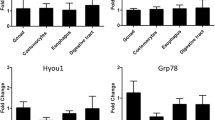Abstract:
Black sea bream (Mylio macrocephalus) hepatic heat shock proteins hsp90, hsp70, and hsp60 were found to be thermally and reversibly inducible as they were elevated 2.0, 3.2, and 2.1 fold, respectively, on acute heat shock and returned to pre-heat-shock levels after a 40-hour recovery period. To establish whether salinity plays a role in regulating heat shock protein (hsp) and insulin-like growth factor-I (IGF-I) expression in a euryhaline marine fish, we adapted groups of juvenile black sea bream to salinities of 50 ppt (hypersaline), 33 ppt (seawater), 12 ppt (isoosmotic), and 6 ppt (hypoosmotic) for 8 months. The lowest levels of hsps were found in fish reared in an isoosmotic salinity and the highest in those adapted to hypersaline and hypoosmotic salinities. Hepatic β-actin messenger RNA abundance remained unchanged in all groups during salinity adaptation, whereas IGF-I mRNA abundance was highest in isoosmotic adapted black sea bream. This study is the first report of an effect of salinity ranging from hypersaline to hypoosmotic on the expression of different hsp forms and IGF-I in fish, and the possible relationship between environmental salinity, hepatic IGF-I expression, and hsp regulation is discussed.
Similar content being viewed by others
Author information
Authors and Affiliations
Rights and permissions
About this article
Cite this article
Deane, E., Kelly, S., Luk, J. et al. Chronic Salinity Adaptation Modulates Hepatic Heat Shock Protein and Insulin-like Growth Factor I Expression in Black Sea Bream . Mar. Biotechnol. 4, 193–205 (2002). https://doi.org/10.1007/PL00021690
Issue Date:
DOI: https://doi.org/10.1007/PL00021690




